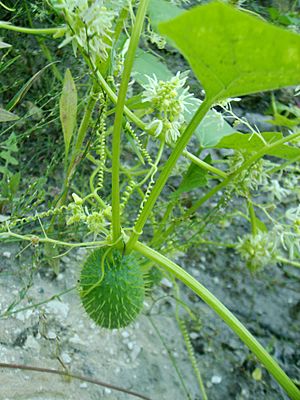Wild cucumber facts for kids
Quick facts for kids Wild cucumber |
|
|---|---|
 |
|
| Scientific classification | |
| Genus: |
Echinocystis
|
| Species: |
lobata
|
| Synonyms | |
Echinocystis is a special type of plant group that has only one species in it. This single species is called E. lobata. Most people know it as wild cucumber, prickly cucumber, or bur cucumber. It belongs to the gourd family, which also includes pumpkins and watermelons. This plant grows every year and spreads out like a vine. It is originally from North America.
Contents
What is Wild Cucumber Like?
Wild cucumber is an annual vine, meaning it grows from seed, flowers, produces seeds, and then dies all in one year. Its stems can grow very long, up to 8 meters (about 26 feet). It uses special curly parts called tendrils to climb over shrubs, fences, or even trail along the ground. The stems have angles and grooves.
Leaves and Flowers
The leaves grow one after another along the stem. They have long stalks called petioles and are shaped like a hand with five finger-like parts. The plant has both male and female flowers on the same plant. This is called being monoecious.
- The male flowers grow in tall, upright clusters called panicles. Each male flower has a white or greenish-yellow outer part with six thin sections. It has one central part called a stamen with a yellow tip (anther) that holds pollen.
- The female flowers are on short stalks near the base of the male flower clusters. Each female flower has a single part called a stigma that receives pollen. Below the flower is a spiky, round part called the ovary, which will become the fruit.
Fruit and Seeds
The fruit of the wild cucumber is spiky and looks like a small, puffy balloon. It can be up to 5 centimeters (about 2 inches) long. It might look like a tiny spiny watermelon or cucumber, but it is not safe to eat. This is why it's sometimes called "bur cucumber." The fruit stays on the plant all winter. When it opens from the bottom, it releases its four seeds.
You can tell wild cucumber apart from a similar plant, the oneseed bur cucumber (Sicyos angulatus), because wild cucumber has six parts on its flower, and its fruits don't grow in tight clusters.
Where Does Wild Cucumber Grow?
Wild cucumber naturally grows across a large part of North America. You can find it in 40 U.S. states and nine Canadian provinces. It does not grow naturally in Nevada, Hawaii, Alaska, or most of the far southeastern U.S. states.
Sometimes, this plant can also be found in other parts of the world where it is not native. For example, it has been seen growing in Hungary and Romania. In these places, it is considered an "alien species" because it was brought there by accident.
How Does Wild Cucumber Interact with Insects?
Wild cucumber is an important plant for many insects.
- The leaf-footed bug Anasa repetita uses this vine as a food source and a place to live. These bugs feed along the stems and on the roots.
- Another type of bug, Euschistus servus euschistoides, also feeds on the developing fruits of the wild cucumber.
- Some wasps, like the scoliid wasp Scolia bicincta and the tiphid wasp Myzinum quinquecinctum, visit the flowers to drink nectar.
- The beetle Chauliognathus pensylvanicus also visits the wild cucumber flowers.
Bacterial Infections in Wild Cucumber
Wild cucumber can get a plant disease called bacterial wilt. This disease is caused by a tiny germ called Erwinia tracheiphila.
- The bacteria are spread from one plant to another by the Striped cucumber beetle Acalymma vittatum.
- When these beetles eat the plant, they can drop their waste (called frass) onto fresh feeding areas. This allows the bacteria to enter the plant and cause an infection.
- Scientists have known since 1911 that wild cucumber is easily affected by this bacterial wilt disease.
Uses of Wild Cucumber
Native American people have used the wild cucumber plant for medicine for a long time.
- The Taos Pueblo people in New Mexico used it to help with rheumatism, which causes pain in joints and muscles.
- The Menominee people in Wisconsin made a bitter liquid from the roots to help with pain.
- The powdered root has also been used to make a soft, moist pack (called a poultice) to relieve headaches.
- The seeds of the wild cucumber have even been used as beads for decoration.
See also
 In Spanish: Echinocystis para niños
In Spanish: Echinocystis para niños

